Inherited traits
The characteristics or traits that are passed from parents to offspring are known as inherited traits. Traits are the defining qualities of an individual. Inherited traits are genetically transferred from the parents to the next generation. Some of the inherited traits include physical traits like, eye color, height, hair color and texture, freckles, blood group, certain diseases, etc. (Figure 1)
Every individual possesses certain unique traits that are a function of their genes and hence, such unique traits are transferred from one generation to the next generation.

Watch this vid about traits, including inherited traits:
Biology definition:
Inherited traits are the traits or characteristics that are transferred from parents to the offspring, genetically. Some of the examples include eye color, skin color and texture, hair color and texture, height, and certain diseases like sickle cell anemia, Alzheimer’s disease, Tay Sachs, and diabetes.
Acquired Traits
Acquired traits are the characteristic feature of an individual which it has acquired through exposure to different environmental factors or external influences and interaction with different species. The acquired traits are not encoded in the genetic material of the individual and hence are not transferred from one generation to the next generation. Some examples of acquired traits include the ability to read, write, play musical instruments, and bodybuilding by regular exercising.
Did you know …?
Mitochondrial DNA is the only DNA that is exclusively transferred from the mother cell to the offspring, i.e., maternal inheritance. Type II Diabetes and multiple sclerosis are suspected to be having link with mitochondrial DNA. Leigh syndrome, lactic acidosis, and mitochondrial encephalopathy are some of the known mitochondrial inherited diseases.
Inherited traits in plants include (see Figure 2):
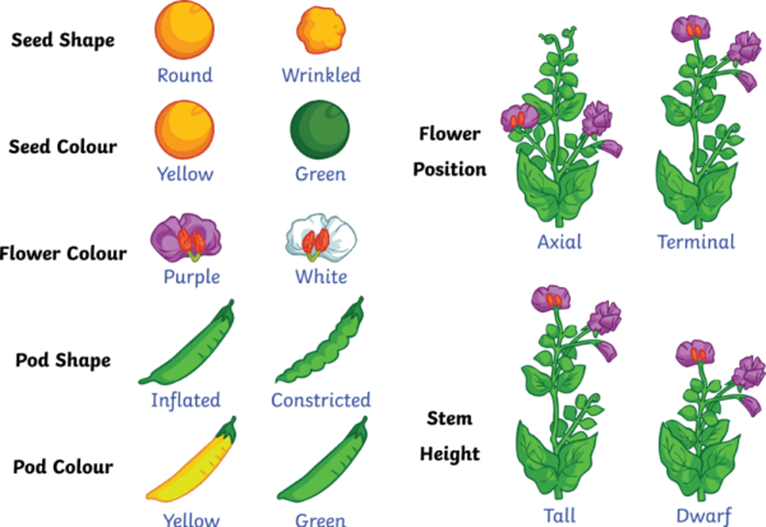
- Stem height
- Flower position
- Pod color and its shape
- Seed color and shape
- Flower color and shape
- Leaf pattern
Inherited traits in animals include: (see Figure 3)
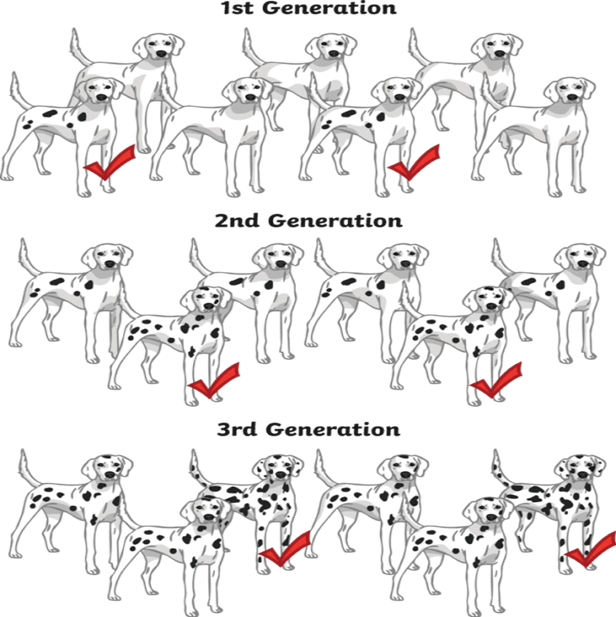
- Body shape and size
- Eye color and shape
- Fur color or coat color and patterns like, spotted/stripped
- Tail shape and length
Rules For The Inheritance Of Traits – Mendel’S Contributions
Pea plants were selected because:
- Ease of growing pea plants and their low maintenance
- Availability of pea plants with distinct and opposing characteristics
- Annual plants and hence multiple generations can be studied in a shorter duration
- Natural self-pollinator plants can also be easily cross-pollinated
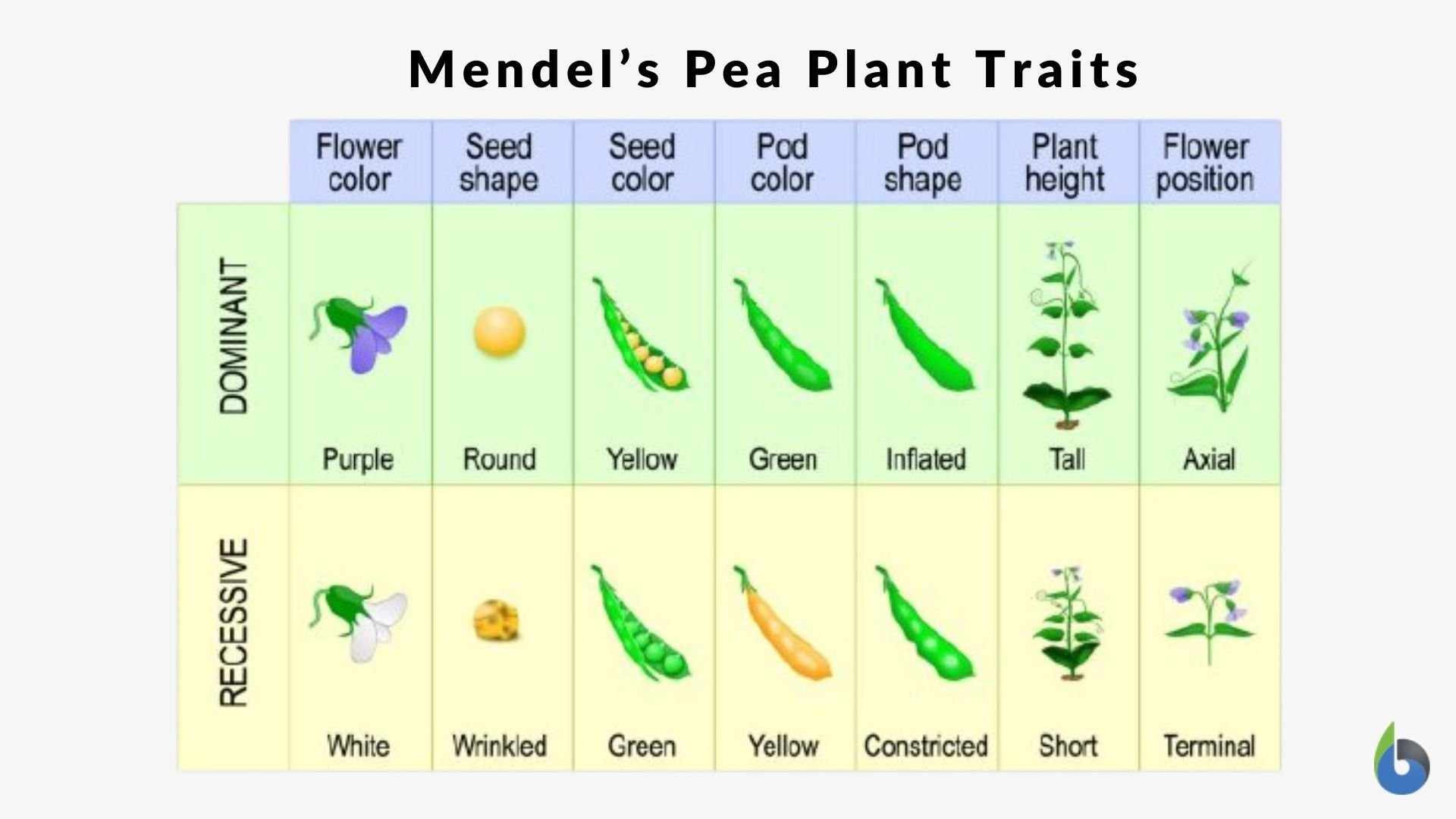
Mendel carried out experiments in two ways:
1. One pair of contrasting characteristics in pure breed line (e.g.: Green pod plant Vs yellow pod plant) – Monohybrid cross (Figure 5)
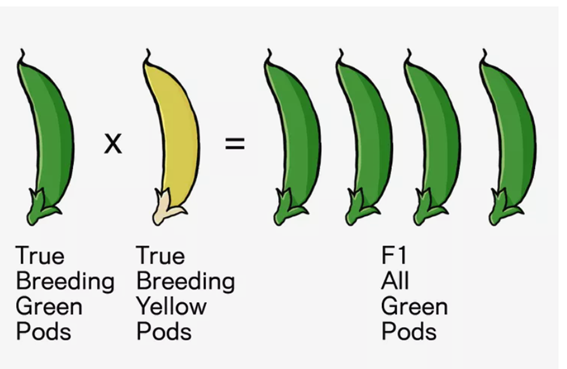
2. Two traits with two alleles (for e.g: green-wrinkled seeds Vs yellow-round seeds) – Dihybrid cross (Figure 6).
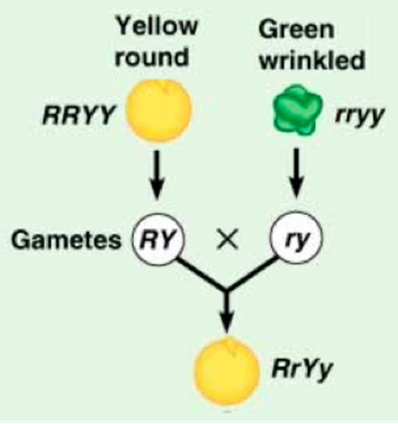
The parent plants having contrasting characteristics were cross-pollinated and the resultant progeny was named as F1 generation (first filial generation). The F1 generation was then self-pollinated and the resultant generation was named as F2 Generation.
Some major observations made in pea experiments include:
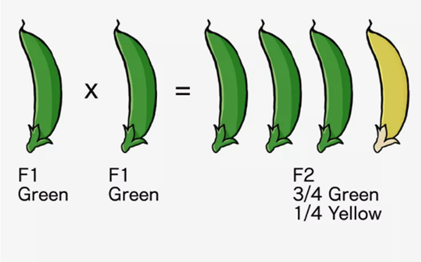
- In a monohybrid cross, pea plants having green pod and yellow pod characteristics were crossed and in the resultant F1 generation, all the plants were green. (Figure 5).
- In the F2 generation of the monohybrid cross, out of four, three plants were green pods and one was a yellow pod. (Figure 6)
- A similar pattern was observed for the other traits/characteristics
These findings led to the following conclusions
- In the F1 generation, traits of only one of the parents are seen while in the F2 generation traits of another parent also appear
- The traits visible in the F1 generation are known as Dominant traits while the trait that appears in the F2 generation is known as Recessive trait.
- Genotype is the genetic constitution while the physical appearance of the trait is known as phenotype.
- Parents transfer genes in pairs to the offspring, known as alleles.
- In gametogenesis, there is a 50% probability that one of the alleles from one parent combines with one of the alleles from the other parent.
- When the two same kinds of alleles are present, it is known as homozygous alleles while the genotype of different alleles is referred to as heterozygous alleles.
Based on these observations and conclusion, Mendel laid upon three laws of inheritance:
- Law of Dominance: This law is also known as the First law of inheritance, according to which, when parents having two contrasting traits are crossed over, the resultant progeny will express the trait of one parent only which is a Dominant trait while the other trait which is not expressed is known as Recessive trait. Of the two alleles in the offspring, the dominant trait will express while the Recessive trait remains unexpressed in the progeny.
- Law of Segregation: This law is known as the Second law of inheritance, according to which, each trait has a pair of alleles. These allele genes segregate and one of the allele genes is transferred to the offspring. Hence, each offspring acquires one set of allele genes from each parent.
- Law of Independent Assortment: This law is known as the Third law of inheritance, according to which, the transfer of allele from parents to offspring occurs independently of each other thus, providing equal opportunity for the alleles to transfer from parents to offspring.

References
- Florez, J. C., Hirschhorn, J., & Altshuler, D. (2003). The inherited basis of diabetes mellitus: implications for the genetic analysis of complex traits. Annual review of genomics and human genetics, 4(1), 257-291.
- · Hopwood, C. J., Donnellan, M. B., Blonigen, D. M., Krueger, R. F., McGue, M., Iacono, W. G., & Burt, S. A. (2011). Genetic and environmental influences on personality trait stability and growth during the transition to adulthood: a three-wave longitudinal study. Journal of personality and social psychology, 100(3), 545–556. https://doi.org/10.1037/a0022409
- · Sanchez-Roige, S., Gray, J. C., MacKillop, J., Chen, C. H., & Palmer, A. A. (2018). The genetics of human personality. Genes, brain, and behavior, 17(3), e12439. https://doi.org/10.1111/gbb.12439
- · Schärli, N., Ducasse, S., Nierstrasz, O., & Black, A. P. (2003). Traits: Composable units of behaviour. In ECOOP 2003–Object-Oriented Programming: 17th European Conference, Darmstadt, Germany, July 21-25, 2003. Proceedings 17 (pp. 248-274). Springer Berlin Heidelberg.
©BiologyOnline.com. Content provided and moderated by Biology Online Editors.









